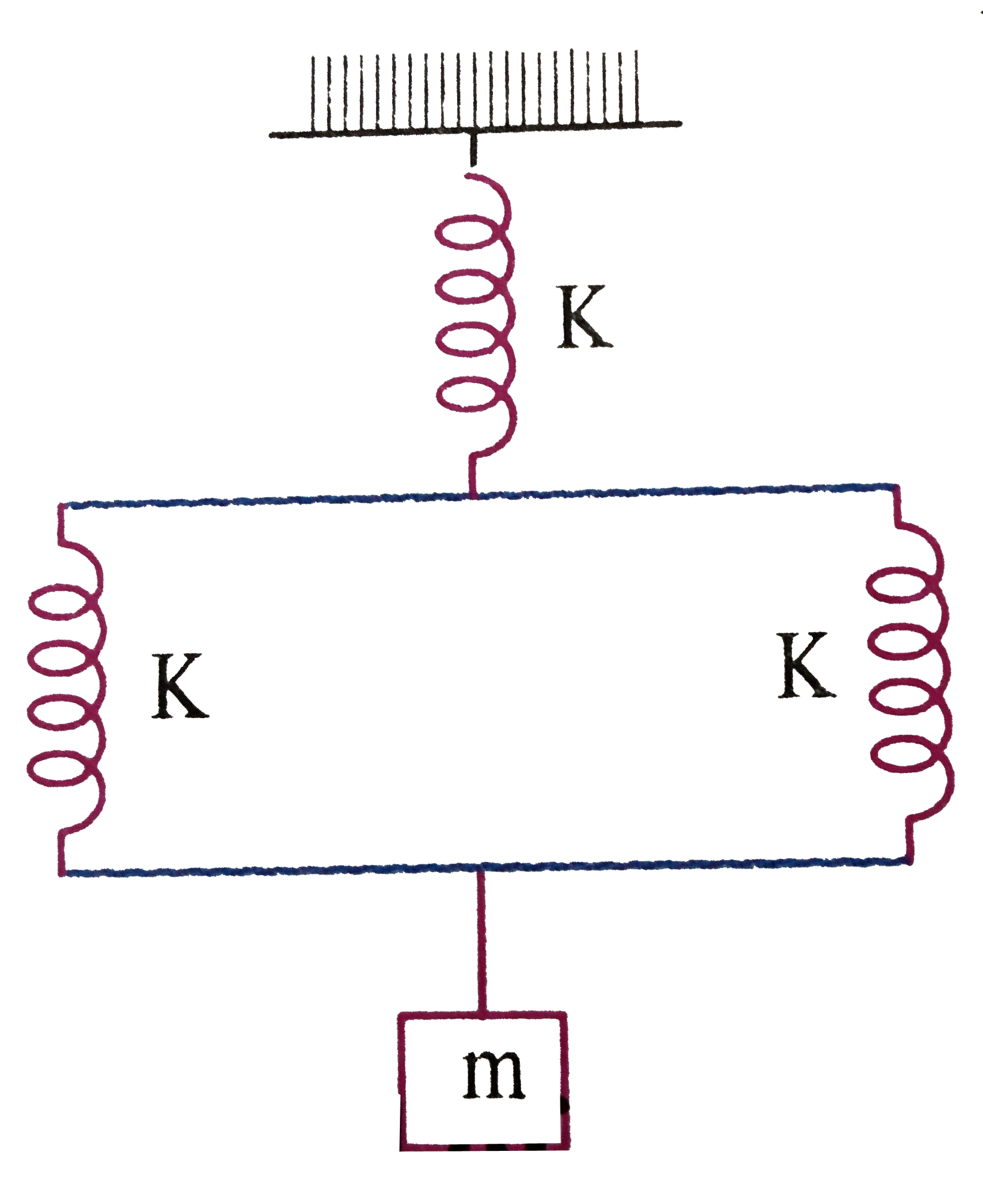A spring balance has a scale that reads from 0 to 50 kg. The length of the scale is 20 cm. A body suspended from this spring, when displaced and released, oscillates with a period of 0.6s. What is the weight of the body? When 50 kg is put, the extension of spring is 20 cm.
The correct Answer is:219.13 N
To solve the problem step by step, we will follow these calculations:
Step 1: Understand the relationship between force, spring constant, and extension
The force exerted by a spring is given by Hooke's Law:
F=k⋅x
where:
- F is the force applied (in Newtons),
- k is the spring constant (in Newtons per meter),
- x is the extension of the spring (in meters).
Step 2: Calculate the spring constant k
We know that when a mass of 50 kg is attached to the spring, it causes an extension of 20 cm (0.2 m). The weight W of the mass is given by:
W=m⋅g
where g≈9.8m/s2. Thus,
W=50kg⋅9.8m/s2=490N
Now we can substitute F and x into Hooke's Law:
490N=k⋅0.2m
Solving for k:
k=490N0.2m=2450N/m
Step 3: Use the period of oscillation to find the mass of the body
The period T of a mass-spring system is given by:
T=2π√mk
Squaring both sides gives:
T2=4π2mk
Rearranging to find m:
m=T2⋅k4π2
Substituting the known values:
- T=0.6s
- k=2450N/m
Calculating m:
m=(0.6)2⋅24504⋅(3.14)2
Calculating (0.6)2=0.36:
m=0.36⋅24504⋅9.8596
Calculating 4⋅9.8596≈39.4384:
m=88239.4384≈22.36kg
Step 4: Calculate the weight of the body
The weight W of the body is given by:
W=m⋅g
Substituting the values:
W=22.36kg⋅9.8m/s2
Calculating:
W≈219.1N
Final Answer
The weight of the body is approximately 219.1 N.
---
The force exerted by a spring is given by Hooke's Law:
F=k⋅x
where:
- F is the force applied (in Newtons),
- k is the spring constant (in Newtons per meter),
- x is the extension of the spring (in meters).
We know that when a mass of 50 kg is attached to the spring, it causes an extension of 20 cm (0.2 m). The weight W of the mass is given by:
W=m⋅g
where g≈9.8m/s2. Thus,
W=50kg⋅9.8m/s2=490N
490N=k⋅0.2m
Solving for k:
k=490N0.2m=2450N/m
The period T of a mass-spring system is given by:
T=2π√mk
Squaring both sides gives:
T2=4π2mk
Rearranging to find m:
m=T2⋅k4π2
- T=0.6s
- k=2450N/m
m=(0.6)2⋅24504⋅(3.14)2
Calculating (0.6)2=0.36:
m=0.36⋅24504⋅9.8596
Calculating 4⋅9.8596≈39.4384:
m=88239.4384≈22.36kg
The weight W of the body is given by:
W=m⋅g
Substituting the values:
W=22.36kg⋅9.8m/s2
Calculating:
W≈219.1N
The weight of the body is approximately 219.1 N.
Topper's Solved these Questions
- OSCILLATIONS BOOK - ICSECHAPTER - OSCILLATIONS EXERCISE - SELECTED PROBLEMS (PERIOD OF OSCILLATION OF (i) A LIQUID IN A U-TUBE, (ii) TEST TUBE FLOAT, (iii) (iii) A PISTON IN AN ENGINE etc.)
9 Videos
- OSCILLATIONS BOOK - ICSECHAPTER - OSCILLATIONS EXERCISE - SELECTED PROBLEMS (OSCILLATION IN A TUNNEL BORED THROUGH THE EARTH)
2 Videos
- OSCILLATIONS BOOK - ICSECHAPTER - OSCILLATIONS EXERCISE - SELECTED PROBLEMS (FROM ENERGY OF AS.H. OSCILLATOR )
9 Videos
- MOTION IN FLUIDS BOOK - ICSECHAPTER - MOTION IN FLUIDS EXERCISE - SELECTED PROBLEMS (FROM POISEUILLE.S FORMULA)
19 Videos
- PROPERTIES OF MATTERBOOK - ICSECHAPTER - PROPERTIES OF MATTEREXERCISE - MODULE 4 ( TEMPERATURE ) UNSOLVED PROBLEMS
12 Videos
Similar Questions
A spring balance has a scale that reads from 0 to 50kg. The length of the scale is 20cm. A body suspended from this spring, when displaced and released, oscillates with period of 0.60s. What is the weight of the body?
View SolutionA spring balance reads forces in Newton. The scale is 20 cm long and read from 0 to 60 N. Find potential energy of spring when the scale reads 20 N.
View Solution
Knowledge Check
A spring balance has a scale that reads from 0 to 50 kg. the length of the scale is 20 cm. a block of mass m is suspended from this balance, when displaced and released, it oscillates with a period 0.5 s. the value of m is (Take g=10ms−2)
A8 kgB12 kgC16 kgD20 kg
When a mass of 5 kg is suspended from a spring of negligible mass and spring constant K, it oscillates with a periodic time 2π. If the mass is removed, the length of the spring will decrease by
View SolutionA force of 6.4 N stretches a vertical spring by 0.1 m. The mass (in kg) that must be suspended from the spring so that it oscillates with a time period of π4 second.
View SolutionA spring elongated by length 'L' when a mass 'M' is suspended to it. Now a tiny mass 'm' is attached and then released, its time period of oscillation is -
View SolutionA body of mass m is suspended from three springs as shown in figure. If mass m is displaced slightly then time period of oscillation is

View SolutionIf the same weight is suspended from three springs having length in the ratio 1 : 3 : 5 , the period of oscillations shall be the ratio of
View SolutionA body of mass m is attached to the lower end of a spring whose upper end is fixed. The spring has negligible mass. When the mass m is slightly pulled down and released, it oscillates with a time period of 3s. When the mass m is increased by 1kg, the time period of oscillations becomes 5s. The value of m in kg is
View SolutionA body of mass m attached to a spring which is oscillating with time period 4 s. If the mass of the body is increased by 4 kg, its time period increases by 2 s. Determine value of initial mass m.
View Solution
